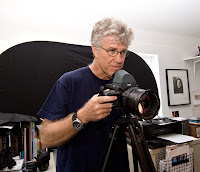



The Professional Photographer Who Mentors Beginning Shooters
by Laura Oles
When it comes to being a working professional photographer, Doug Box has experience to spare. In addition to shooting countless weddings and portraits, he has taught photography in forty-eight states, in eight counties and on five cruise ships. Needless to say, Doug Box is busy. And he tells us that he wouldn’t have it any other way.
“Each week is different for me,” Doug says. “I spent all last week teaching, but I still need to keep up with clients and return calls when I’m on the road. Now I’m back and getting ready to shoot a wedding. I like the variety. I like that I’m in a position to do a number of things.”
And according to Doug, being a professional photographer today—and being one that can make a living at it--requires the ability to handle a number of different tasks and projects. “Being a niche photographer is far more difficult today than it was twenty years ago. People’s expectations have changed and what they want has changed also.”
One of the things that Doug has embraced is being a teacher and mentor to new photographers who want to learn and become better behind the camera. “Today’s technology has made some things easier and other things more difficult. Learning things such as how to properly expose an image digitally is a skill that has mystified many people. My goal is go take the mystery out of it.” In fact, Doug is so passionate about teaching newbies that he recently purchased an online forum called Prophotogs.com. There are currently 700-800 photographers online searching for help and guidance. “One of the things I do is post quick video critiques to give people concrete feedback on the images they submit for review. Just telling someone that the image looks good isn’t helpful. They need specific direction on what works, what doesn’t, and why.”
Doug feels a real connection with beginning photographers because “all the pros were once beginners.” When asked what are the most important things beginning photographers need to know, Doug provided a few recommendations sure to take starting shooters to the next level:
Learn How ISO, F/Stop and Shutter Speed Work Together: These items are the three pillars of proper exposure. “This can be one of the most confusing things for beginners to learn but it is critical to have this foundation before tackling other subjects. The rest of your skill set is built upon this base.” Doug says that he and good friend (and fellow pro photographer) Randy Kerr realized that it was much easier for them to learn these basics when they were shooting film. “When we were getting started, all of these settings were shown on our camera lens and we could visually see the relationship between them because we looked at it every day. With digital, you just see the settings on the back of the LCD screen. You don’t see how one change affects the other settings. That’s part of what makes it more confusing today.”
It was this realization that led he and Randy to create the Exposure Calculator (which can be found at www.dougbox.com/shop/) This specialized card has dials that allow you to adjust one aspect of your image (F/stop, shutter speed or ISO) and see how this change affects the other settings. “I’ve seen the light go on with so many people after using this tool for a little bit. It jus helps them understand the relationship.”
Learn How to Set a Custom White Balance: Along with proper exposure, Doug feels this is important because it affects a fair percentage of total photographs taken. “Learning how to set a custom white balance for your photographs and learning how to use the presets on your camera will make a substantial impact on the quality of your photographs,” Doug offers. “Take a look at what light is on your subject. You need to be able to make adjustments.”
Learn about Metering: “So many people use their in camera metering and I think they really need to learn how to use an handheld meter. When a camera sees white, it’s trying to calibrate to grey, and when this happens, your images can end up underexposed and it can make the snow appear grey. Likewise, when your camera sees black, it thinks the color is grey and tries to correct it, which means your images can become overexposed. Learning how to spot meter and evaluative meter can help you overcome your camera’s assumptions. You have to be smarter than your camera.”
